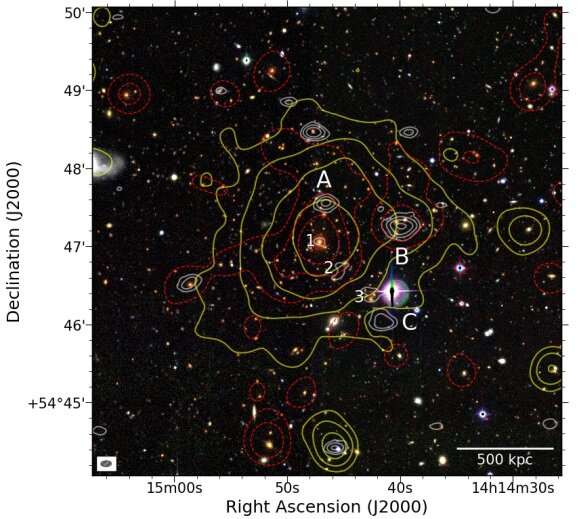July 31, 2019 report
Radio halo detected in the galaxy cluster PSZ2 G099.86+58.45

Using the LOw Frequency ARray (LOFAR), astronomers have probed PSZ2 G099.86+58.45, one of the densest cluster of galaxies known to date. The study revealed the presence of a radio halo in this cluster, making it one of the most distant such features ever discovered. The finding is detailed in a paper published July 24 on arXiv.org.
Radio halos are enormous regions of diffuse radio emission, usually found at the centers of galaxy clusters. However, diffuse emissions generally have very low surface brightness, particularly at GHz frequencies, what makes them hard to detect. Their brightness increases at lower frequencies, unveiling the presence of these regions.
With the capability of obtaining deep, high-resolution, high-fidelity and low-frequency radio images, LOFAR is an excellent tool to study radio halos at low frequencies with unprecedented detail and sensitivity. So a group of astronomers led by Rossella Cassano of Institute for Radio Astronomy of Bologna, Italy, employed LOFAR for the observations of the galaxy cluster PSZ2 G099.86+58.45.
At a redshift of approximately 0.62, PSZ2 G099.86+58.45 (PSZ2G099 for short) is a massive and hot galaxy cluster of about 684 trillion solar masses. Observations have shown that the cluster resides in a high-density environment, about six times denser than the average Lambda cold dark matter (ΛCDM) model prediction at this redshift.
Cassano's team investigated PSZ2G099 with LOFAR as part of the LoTSS (LOFAR Two-meter Sky Survey) program. They also conducted follow-up observations of the cluster using the Karl G. Jansky Very Large Array (JVLA). All in all, the observational campaign resulted in the detection of a radio halo in this object.
"In this letter, we report the discovery of a radio halo in the high-redshift galaxy cluster PSZ2 G099.86+58.45 (z = 0.616) with the LOw Frequency ARray (LOFAR) at 120-168 MHz," the astronomers wrote in the paper.
In particular, LOFAR observations at medium resolution revealed extended diffuse emission at the center of PSZ2G099, with dimensions measured at around 3.9 by 1.95 light years. As expected, this emission is very faint at higher frequencies and therefore was barely detected by JVLA.
The astronomers added that the morphology of the observed radio emission resembles that of the X-ray emission as seen on images provided by ESA's XMM-Newton spacecraft.
Taking into account the emission's extension, morphology, and location in the cluster, the researchers classified it as a radio halo. Moreover, the cluster's redshift places it among the most distant radio halos discovered so far, and the furthest away detected by LOFAR.
In concluding remarks, the authors of the paper report that the study shows LOFAR's potential as a unique system to discover radio halos at high redshift. Given that the fraction of clusters with radio halos at high redshift and their luminosity depend on the magnetic field, the scientists hope that LOFAR statistical studies of such halos could deliver essential information on the origin of magnetic fields in galaxy clusters.
More information: LOFAR discovery of a radio halo in the high-redshift galaxy cluster PSZ2 G099.86+58.45, arXiv:1907.10304 [astro-ph.GA] arxiv.org/abs/1907.10304
© 2019 Science X Network





















